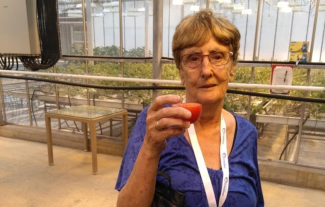Grumpy Thought vs Smiley Thought

Negative thoughts about her stammer almost stopped Phyllis Edwards from pursuing her dream job. Here she writes about battling those thoughts and learning valuable lessons from the children she teaches.
When I was a young caregiver for my mother, the idea kept going around in my head that I wanted to follow my dream and train to be an early childhood teacher. After all, I knew I got on well with children. But negative thoughts soon got to work, telling me that maybe I should give up this dream because of my stammer. Thoughts such as: I don't have any children myself, and that I would have to train to get a degree, which would mean at the very least introducing myself in different situations. I named this 'Grumpy Thought'.
But positive thought, which soon became known as 'Smiley Thought', kept reassuring me. I knew I was a popular babysitter and that my experience of having a stammer gave me extra empathy and understanding.
Negative thoughts soon got to work, telling me that maybe I should give up this dream because of my stammer.
But then along came Grumpy Thought, pushing its way back through. I kept worrying how I'd be able to talk to and read to the children. I began to wonder if my stammer would allow me to follow my dream. However, Smiley Thought started coming through much stronger. This was combined with the amount of encouragement and support I got from tutors, teachers, colleagues, family members and friends, who stuck with me for the long haul and are still here today. They know who they are.
I applied and got accepted to study for my degree in education. Whenever Grumpy Thought made me think, "Oh, I'll have to read stories to the children. How will I do that, what if I stammer?", Smiley Thought would bounce right back with, "This would be a unique opportunity for me to make a difference to children and families." I began to realise that yes, I am worthy to do this job; yes, I can follow this dream, and with a nudge from God and the need to test my self–worth, I pushed through.
Acceptance & love
The strongest Grumpy Thought that kept coming and going and pulling me down, was how on earth I would manage to read a story to the children. What if I blocked, stopped talking and they lost interest? But positive Smiley Thought taught me a big learning curve. I thought, "I can do this, but I need some strategies." When reading a book to the children, the strategy I used was to encourage them to listen closely and see if they could hear their name in the stories. I soon noticed that when I was reading, the children didn't seem bothered if I stopped talking because they knew the story would have a twist and they were eager to see how I would incorporate their name into the story. They wanted to know what hero they would be or what act of kindness they would carry out.
These experiences taught me the most important lesson: acceptance and love. I realised children don't care if you are different. They see past all that. Take Joe, for example. We shared lots of stories and when I came back to work Joe was waiting at the door for me with one of his favourite books that he wanted me to read to him, called 'There's a hole in my bucket'. Later in the playground, I was pushing Joe on the swings. I was eager to try and embrace my stammer more, having been inspired at the STAMMA/BSA Cardiff conference in 2018. I said, "Joe, we have fun when we read stories together even if I do stop sometimes." Without stopping swinging, Joe replied, "I love you, Phyllis, even if there is a hole in your bucket."
'Grumpy Thoughts' can come but those 'Smiley Thoughts', with the acceptance and love that comes with them, win out every time.
Then there was Ariki, who taught me that being read a story by a teacher with a stammer didn't matter to him either. He used to seek me out with books to read. He didn't notice the gaps, but he soon noticed if you didn't or couldn't keep your promise to read the story in the first place.
I started bringing toys in too. Dillis Duck couldn't quack like her siblings, but with her amazing squeak and her very kind heart, she had amazing adventures to tell. She became a very popular visitor at my work. One day when Dillis was visiting, I asked for help from the children to help Dillis tell another of her exciting adventures. The response was instant. Three girls, Lucy, Charlotte and Eden, all aged 4, volunteered to join in. They did just the best job. I felt so humbled, I had a lump in my throat as it taught me yet again, what love and acceptance children show.
So yes, Grumpy Thoughts can come but those Smiley Thoughts, with the acceptance and love that comes with them, win out every time.
I'm telling my story to show some of the reasons why I love and feel it is a privilege to be an early childhood teacher with a stammer.
Read more great articles at our Your Voice section. Want to write something yourself? Go to Submit Something For The Site to find out how. See our Get Help section to see what help you can get for stammering.

































